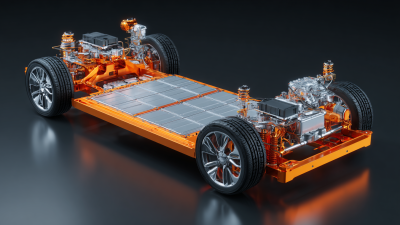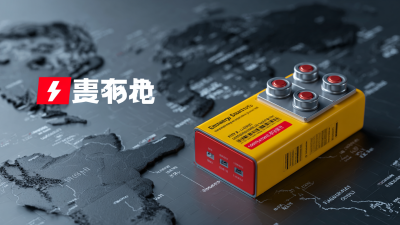Exploring the Future of Energy Storage with Lithium Polymer Batteries for Everyday Devices
In recent years, the evolution of energy storage has taken center stage, particularly in the realm of everyday devices, where efficiency and portability are paramount. Among various technologies, the Lithium Polymer Battery has emerged as a frontrunner due to its lightweight design, flexibility in form factor, and enhanced safety features. According to a report by Market Research Future, the global lithium polymer battery market is projected to grow at a CAGR of over 20% from 2021 to 2027, driven by the increasing demand for mobile devices, electric vehicles, and renewable energy applications. This substantial growth highlights the critical role that Lithium Polymer Batteries will play in shaping the future of energy storage.
As consumers seek devices that not only perform better but also last longer, the companies that innovate with Lithium Polymer Battery technology are positioned to meet these evolving needs. The ability of these batteries to deliver high energy density while being lighter than their counterparts puts them at a significant advantage. Furthermore, studies indicate that Lithium Polymer Batteries have a lower risk of leakage and thermal runaway, making them a safer choice for integration in compact consumer electronics. As we delve deeper into the intricacies of Lithium Polymer Battery technology, we'll explore its potential, applications, and the implications for everyday devices in our quest for more efficient energy solutions.

Advancements in Lithium Polymer Battery Technology and Their Impact on Energy Storage
Lithium polymer batteries have emerged as a game-changer in the energy storage sector, particularly for everyday devices such as smartphones, laptops, and wearable technology. Recent advancements in lithium polymer technology have significantly improved energy density, resulting in batteries capable of storing up to 200 Wh/kg, which is a considerable improvement over traditional lithium-ion batteries. This enhancement not only increases device efficiency but also contributes to the miniaturization of technology, allowing manufacturers to produce lighter and more compact gadgets. According to a report from Allied Market Research, the global lithium polymer battery market is expected to reach $27 billion by 2025, growing at a CAGR of 10.9%.
Tips: When selecting devices powered by lithium polymer batteries, consider longevity and charging time. Devices with integrated battery management systems can enhance battery lifespan and ensure safety during charging. Additionally, look for products that utilize fast charging capabilities without compromising battery health.
The impact of advancements in lithium polymer battery technology extends beyond consumer electronics. In sectors such as electric vehicles (EVs) and renewable energy storage, these batteries are crucial in supporting the transition to sustainable energy solutions. With improvements in charging cycles and thermal stability, lithium polymer batteries are becoming increasingly viable for larger-scale applications. As these innovations unfold, they play a pivotal role in the push for greater energy efficiency and reduced carbon footprint across various industries.
Tips: For ecological sustainability, always recycle lithium polymer batteries properly. Seek out local recycling programs to ensure responsible disposal and reduce environmental impact.
Exploring the Future of Energy Storage with Lithium Polymer Batteries for Everyday Devices
| Dimension | Values |
|---|---|
| Energy Density (Wh/kg) | 150-200 |
| Cycle Life (Cycles) | 300-500 |
| Charge Time (Hours) | 1-2 |
| Operating Temperature (°C) | -20 to 60 |
| Common Applications | Smartphones, Tablets, Drones |
| Safety Features | Overcharge Protection, Thermal Management |
| Environmental Impact | Recyclable Components |
Comparative Analysis: Lithium Polymer Batteries vs. Traditional Lithium-Ion Batteries
Lithium polymer batteries (LiPo) have emerged as a compelling alternative to traditional lithium-ion (Li-ion) batteries, particularly for everyday devices. One key advantage of LiPo batteries is their form factor; they can be manufactured in various shapes and sizes, allowing for greater flexibility in design. This adaptability makes them ideal for consumer electronics such as smartphones, tablets, and wearable devices, where space is often a premium. Additionally, LiPo batteries typically possess a higher energy density, meaning they can store more energy in a smaller volume, which can lead to longer usage times between charges.
On the other hand, traditional lithium-ion batteries have established themselves as reliable and cost-effective solutions over the years. They generally offer longer cycle life and greater durability compared to their LiPo counterparts. However, Li-ion batteries are often heavier and bulkier, which limits their application in ultrathin and lightweight devices. Furthermore, safety concerns regarding Li-ion batteries, such as the risk of thermal runaway, have prompted manufacturers to explore LiPo batteries as a safer alternative. As technology continues to advance, the comparative advantages of lithium polymer batteries could redefine energy storage for everyday applications, paving the way for innovations that enhance user experiences and device performance.
Applications of Lithium Polymer Batteries in Everyday Devices: A Detailed Overview
Lithium polymer batteries (LiPo) have emerged as a game-changer in the energy storage sector, particularly for everyday devices. Their lightweight design and flexible form factor allow manufacturers to create sleek and compact gadgets, enhancing user experience. According to a report by MarketsandMarkets, the lithium polymer battery market is projected to reach $5.23 billion by 2024, growing at a CAGR of 20.8% from 2019 to 2024. This growth is driven by the increasing demand for portable electronic devices, electric vehicles, and renewable energy storage solutions.
In everyday applications, LiPo batteries are extensively used in smartphones, tablets, drones, and wearable technology. These batteries offer a high energy density and deliver consistent power, which is crucial for devices that require long-lasting performance. A study from IDTechEx highlights that the adoption of lithium polymer batteries in consumer electronics could lead to a 15-20% increase in efficiency over traditional lithium-ion cells. The ability to customize battery shapes also enables innovative product designs, making them an integral part of the modern electronic landscape. As the technology matures, we can expect to see even wider applications and enhancements that will redefine how we interact with our devices.
Exploring the Applications of Lithium Polymer Batteries in Everyday Devices
Challenges and Solutions in Scaling Lithium Polymer Battery Production for Consumer Electronics
The transition to sodium-ion batteries represents a significant shift in the energy storage landscape, particularly in response to challenges faced by lithium-ion technology. With the global sodium-ion battery market projected to grow from US$ 438 million in 2024 to over US$ 2,104 million by 2033, the technology is becoming an increasingly viable alternative for consumer electronics. However, this transition is not without its hurdles; dual constraints of technological limitations and market readiness persist, posing challenges for mass production.
As the demand for batteries surges, the industry is confronted with the need for innovation alongside scaling production. Reports indicate that as the electrification trend accelerates, producing high-quality batteries at scale will be essential. Companies must invest in new technologies while also ensuring the sustainability and efficiency of the battery lifecycle. This dual challenge underscores the importance of strategic pivots, such as Japan's shift from lithium to sodium batteries, aimed at bolstering energy storage resilience.
Tips: When considering battery options for consumer electronics, evaluate both performance and sustainability. Investing in technologies that emphasize recycling and circular economy principles can enhance the longevity of battery materials. Additionally, staying informed about emerging trends, such as silicon-anode technology, can provide insights into future advancements that may impact choices in energy storage solutions.
Future Trends in Energy Storage: What to Expect from Lithium Polymer Innovations
The future of energy storage is increasingly leaning towards innovations in lithium polymer batteries, which promise to reshape the landscape of power solutions for everyday devices. One significant trend is the enhancement of energy density, allowing these batteries to store more energy in smaller, lighter packages. This improvement not only contributes to the efficiency of portable gadgets like smartphones and laptops but also caters to the growing demand for energy-efficient solutions in various industries.
Another key development is the emphasis on safety and longevity. Lithium polymer batteries are engineered to reduce the risk of thermal runaway, a common issue with traditional batteries. Innovations in battery chemistry and protective materials are making these batteries not only safer for users but also more durable, thus extending their lifecycle. As researchers continue to push the boundaries, we can expect lithium polymer technology to integrate seamlessly into the Internet of Things (IoT), electric vehicles, and renewable energy systems, driving sustainability and convenience in daily life.
Related Posts
-

Exploring the Future of Energy Storage with the Best Lithium Polymer Battery Technology
-

How Best Forklift Battery Optimizes Warehouse Efficiency with Real World Applications
-

Future of Solar Battery Market by 2025 and How to Choose the Best Option for Your Needs
-

Navigating the Setbacks in Energy Storage Battery Standards: A Global Perspective
-

7 Reasons Why the Lithium Iron Phosphate Battery is the Best Choice for Your Energy Needs
-

Innovative Flow Batteries Revolutionizing Energy Storage Industry at 2025 China Import and Export Fair
